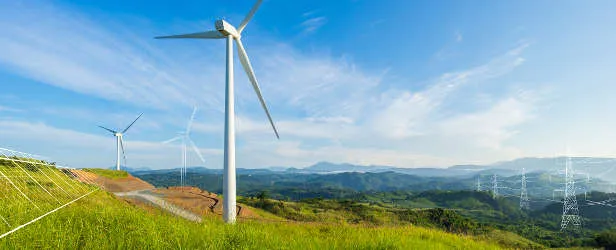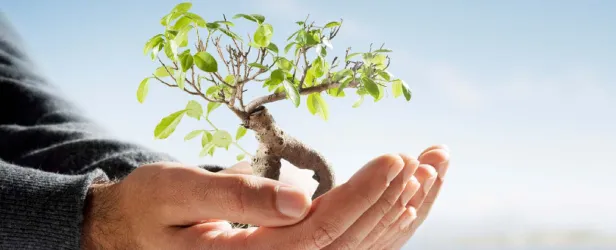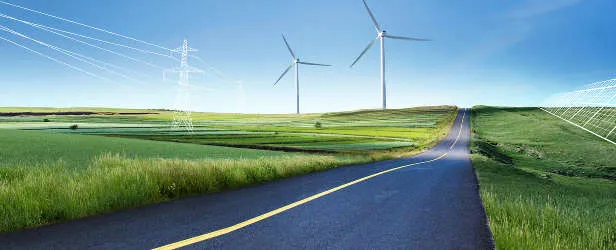December 20, 2018 | Podcast
Financing the Energy Transition
Transcript:
Transcript:
NARRATOR Welcome to the DNV Talks Energy podcast series. Electrification, rise of renewables and new technologies supported by more data and IT systems are transforming the power system. Join us each week as we discuss these changes with guests from around the industry.
Transcript:
MATHIAS STECK Welcome to a new episode of DNV Talks Energy. My guest today is Xiaodong Wang, Senior Energy Specialist of the World Bank, and lead author for the Energy Chapter of the World Development Report 2010, Development and Climate Change. Welcome Xiaodong.
Transcript:
XIAODONG WANG Thank you.
Transcript:
MATHIAS STECK Xiaodong, we want to talk about the role of banks and governments and how they can and have to understand renewables and related technologies better to support the energy transition. But before we go there, it would be great if you could introduce yourself as a person and World Bank.
Transcript:
XIAODONG WANG Okay, sure. Thank you very much for inviting me. Again, my name is Xiaodong Wang. I work at the World Bank, Energy with our Global Practice. So, I’ve been working in [the] clean energy, energy efficiency field for the past 20 years, and now I mostly focus on Asia, and a little bit in East Europe as well. And so, World Bank, the World Bank Group basically is the leader in the climate financing and the multilateral development world. And we are very proud that we financed $20 billion in climate investment last year, and that is about 32% of entire portfolio, and that actually exceeded the 28% that we committed, the target by 2020. That has not been easy. So, I’m very proud that I’ve been part of the World Bank Group and the Energy team, to work on clean energy, energy efficiency in Asia.
Transcript:
MATHIAS STECK Very good. Xiaodong, one thing which I would also like you to elaborate on is the different roles World Bank as well as the IFC are playing in this. Could you elaborate a little bit on that?
Transcript:
XIAODONG WANG Sure. So, our World Bank Group actually has World Bank, IFC and MIGA, the guarantee group. The World Bank is mostly working with the government. So, we’re proud that we are the policy advisor, and we are the knowledge bank, and we are also a lender. Right? But we do the sovereign guarantee to the government. But IFC is our private sector arm. So, they directly lend to the private investor, private sector, without the sovereign guarantee. So, that’s mainly the primary difference.
Transcript:
MATHIAS STECK When we look at the energy transition ahead, what has to happen to mitigate, limit climate change? There is a tremendous build-out we need in renewables; mainly solar PV, but also onshore wind and offshore wind. So, how can the finance sector, how can banks support that transition, which will cost a tremendous amount of money?
Transcript:
XIAODONG WANG So first of all, I’m a firm believer that policy drives financing. Because without the policy, financing is just on the supply side. Right? So, first of all, we need to really have effective, conducive policies to put into place, to create this enabling environment to attract investors; and also, to create market demand. So, for Southeast Asia region, for example, if we look at the global trend, the investment for renewable energy already exceeded the investment for fossil fuel. But this region, most of the countries go the other way, other direction, where coal is ramping up very quickly, and renewables are still pretty much lagging behind the global scene. So, it’s really important to put in place effective policy; specifically would be the sufficient tariff level with long-term power purchase agreement. Provide certainty for investors.
I think there’s a myth in the region that renewables is more expensive. That’s why people go massive, go coal. But in reality, that’s no longer the case, right, thanks to the dramatic cost reduction for solar, for renewables over the recent years. So, for example, we have seen, an increasing number of countries have achieved three to six cents per kilowatt hour for solar PV through our competitive auction schemes. So, in particular, in China, India and South Africa, those are the coal countries, where coal dominates, and solar PV is already competitive with coal. There’s no need even for a subsidy. I think this is where Southeast Asia needs to learn to borrow from this experience, to put into effective policies, like renewables, to take off.
Transcript:
MATHIAS STECK Right. You mentioned India just now. And it’s quite incredible that they might actually leapfrog coal in many areas because they can deploy solar in large scale into very competitive prices. One thing we hear from financers, maybe, rather, equity financers who are still very interested also in renewables, is that they have money available, but they struggle to find bankable projects and that also sometimes comes back then to regulation. When you look around in this region, Southeast Asia, maybe twofold – what would be your wish, you see more? And do you see some good examples in some countries supporting the development of renewables?
Transcript:
XIAODONG WANG Yes. So, first of all, after you put into policy, if I see something more, that would be more policy to drive the demand. Because like you said, we, as a banker, this is the number one challenge we face; whenever we set up a clean energy financing facility, there’s no deals. So, in this region, there’s no lack of liquidity really, and we put in lots of those projects as well. But really, finding the bankable deals is really important. So, one side is that policy drives the demand. But once you have the policy, for most renewable projects – with a few exceptions, concentrated solar power is new, geothermal risk, the risk, rooftop PV, so there are a few exceptions – but mostly, for solar, onshore wind, once you have the effective policy, finance usually will follow. But for those new technologies, for energy efficiency particularly, for example, it’s really that there’s a risk. Right? There’s a geothermal drilling risk, there is a credit risk for small-medium size enterprises, particularly venture efficiency for rooftop solar PV.
So, and the banks are particularly notorious. They are most risk averse. So, this is where, I think, we and the public funding – we, as a multilateral bank and public funding – come in. There’s smarter money. So, for example, risk sharing. A partial risk guarantee can share the risk, and that can leverage a tremendous amount of private and commercial financing. And we also do, what we call credit line; our money goes through local banks that they can learn by doing and then can leverage their funds, and then mainstreaming clean energy investment in these banks. So, we have some of these instruments. We have done those. So, some examples. In Indonesia, we have done big, on geothermal; guarantee approach, our concessional financial financing approach. And now, we recently started energy efficiency credit line and that’s based on some of the examples we have elsewhere. Like in China, we have energy efficiency financing with local banks that leveraged our World Bank money eight times. We did a $3 billion investment with one project. And then the bank, from [the] beginning, not knowing what energy efficiency investment looks like, in the end, used their own money to mainstream, become a mainstream business line. So, these are the changes we have seen.
Transcript:
MATHIAS STECK Right. So, it’s about getting used to the way finance is deployed to these new technologies.
Transcript:
XIAODONG WANG Yes. Because the banks feel – they always say – oh, clean energy is for social, is for [the] environment. We are commercial; we are here to make money. But they don’t know that actually, renewable energy, clean energy, energy efficiency is not only good for the environment; it also can make money and has actually a low default. So, that’s why when we do this risk sharing, when we do this credit line with the local banks, through this learning by doing process, they realize that this is a profitable business.
Transcript:
MATHIAS STECK So it’s basically about banks and financers getting used to how to invest in these new technologies?
Transcript:
XIAODONG WANG Yes. So, most of the banks we run into often say these clean energy projects are for the environment, are for social causes, and we are a commercial entity, we’re here to make money. So, I think it’s really important for them, through this learning by doing process, they understand that these clean energy projects are profitable – they can make money – and are also good for the environment, and they also have a low default as well. So, through our operation, our project and risk sharing, risk guarantee, and through these credit lines through local banks – I just gave the example – through learning by doing, they really understand then these projects are good for their bottom line.
Transcript:
MATHIAS STECK You raised a very interesting point just now with saying we are not social, we are commercial. And it’s interesting because if you look back maybe ten years or so, we were maybe the people who wanted to save the world when we talked about renewables, and it didn’t really pick up because it wasn’t maybe financially viable, or it wasn’t a good business case – it was more expensive. Now, it has become cheaper, in many cases, than conventional generation.
But what we still see is also utilities being worried about what happens to their grid if they have a large intake of renewables. So, there’s a lot about building the awareness in the region, how these things can be done. What strikes me always is we see all these examples from Europe where we sometimes have 70% renewables in a German grid or something. So, it seems to be doable. But what do we have to do to make people understand that this technology can be adopted and is technically possible?
Transcript:
XIAODONG WANG Yes. So, it’s very typical. We actually just did a workshop on that exact topic in China several weeks ago. So, it’s very typical that you see these different stages of countries. When they start, it’s renewables. Particularly, we talk about variable solar PV and wind. And the utility will be resistant. That resistance is not just awareness. It’s also when the renewables, especially, distributed their generation online, it hurt their bottom line, cutting away from their share of the market. So, you see this strong resistance. And then, when the country’s renewables’ shares start to grow, you see that the utilities realize that they have to get on the train; otherwise, they get left out in the market. So, then they start to more embrace this idea.
So, you see these changes, almost in every country, phase by phase. So, at the low share of this variable renewables, we have seen no evidence really to have major impact on the stability, the security of the grid. But when the shares start to grow, yes, many things need to be done. So, there’s a technical solution in terms of storage, for example – battery storage, heat storage and pump storage. And make the generation more flexible with more gas, make it more flexible. And then there is, on the transformation side, make it more flexible in terms of regional integration. So, there are technical solutions. There is a regulated solution to get this done. But the fact is that we just visited people in China, in Qinghai province; they did 100% renewables to the grid in a straight nine days. And then we have Denmark and Germany, all these European experience that it’s technically doable. I think it’s really to bring on the utility, need to change their mind – because the train left the station – that they have to get on board.
Transcript:
MATHIAS STECK In conferences like here, the Singapore International Energy Week, we talk a lot about advances in technology, digitalization, everything. One thing which I’m missing a little bit is this awareness of the urgency. So, our own energy transition outlook came up with a carbon budget which is way beyond the 810 gigatons which we thought would be healthy for the world. And there was recently, beginning of October, a UN report which said that we have 12 years to make a real impact. Now, looking again into this region here in Southeast Asia, we see the primary energy demand peaking somewhere in 42, and the increase in CO2 emissions also going, or increasing beyond 30. So, we have a very joint responsibility here to make it better. What would you say is, for example, World Bank’s contribution? What can you do to do even more than the great successes you showed at the beginning?
Transcript:
XIAODONG WANG So, first of all, like you said, we all talk about two degrees, 1.5 degrees. If we continue on the current path, that’s almost impossible now. And we are heading to a six degrees world. And what does six degrees mean? You know that from the ice age to now, the difference is six degrees. So, that – we’re heading to a disaster. So, the urgency is definitely right there. But like you said, we discussed some regions, and particularly here – right here, close to home – many of the Southeast Asian countries still, not only is the absolute amount of coal going up – the share is going up. We now have this Energy Transition Asia initiative, we looked at six countries in Asia – that counts about 75% to 80% of the new-build coal capacity in the world, it’s right here in this region. So, really, the time to act is now.
So, as the World Bank, again, like I mentioned, for example, we have this Energy Transition initiative where we’re helping these Asian countries with concessional financing, with policy advice, technical assistance and this capacity building, and also together with our lending, to help them to reverse this trend. To, through policy advice, for example, pilot solar auction, and then to scale up renewable energy together with concessional financing. And also on the energy efficiency side. I think it’s always forgotten often, if nobody mentions about it. But if you look at IEA, look at real scenarios, it provides more than half of the emission reduction potential. And it’s the cheapest option. So, from both energy efficiency and clean energy, we are trying to do more. And we recently also announced that there’s a battery initiative. We’re going to do $1 billion on battery, and that hopefully can help the market drive down the cost, and leverage more private financing to have more breakthroughs on the new technology as well.
Transcript:
MATHIAS STECK That leads me to one more question, what you just said. And so, World Bank, we talked about a lot of investment going into energy efficiency, renewable energy. Are we already talking about investments into mitigating climate change events? Is that happening already – people assuming the climate change will hit us as bad as we think and there’s projects now to mitigate this, meaning…?
Transcript:
XIAODONG WANG Adaptation.
Transcript:
MATHIAS STECK Adaptation.
Transcript:
XIAODONG WANG Yes, precisely. Our World Bank Group climate change strategy is equally really mitigation, but also the adaptation side. Because like you said, climate change, like it or not, is happening, and particularly the developing countries are the vulnerable ones. So, we have quite a big adaptation investment to help, for example, the disaster relief, particularly along the coastal cities, and also agriculture in Africa. So, we have quite a bit of both policy advice, technical assistance as well investment on the adaptation side, in addition to the clean energy and the mitigation side, as well as transport.
Transcript:
MATHIAS STECK Right. We have unfortunately already come to the end of this podcast. But we record here at the site of the Singapore International Energy Week 2018. How well do you think is the slogan, Invest, Innovate, Integrate, aligned to the current problems we see?
Transcript:
XIAODONG WANG Yes. So, this slogan really, I think, captured what action needs to be done. We talk about investment. And in order to really stabilize emissions, we really would need innovation, the innovative technology to come in, particularly if we look at the 2050 time horizon. And integrate – like I mentioned, we just talked about not just energy. Now, you integrate urban, to transport. And this country, this city is a great example in the world; how you integrate energy [and] urban transport together. So, I think per lead in that way to integrate these together towards a low carbon path.
Transcript:
MATHIAS STECK Thank you very much, Xiaodong, for your very interesting insights. It was nice having you here. And to the listeners, that was Xiaodong Wang, Senior Energy Specialist from the World Bank.
Transcript:
XIAODONG WANG Thank you.
Transcript:
NARRATOR Thank you for listening to this DNV Talks Energy podcast. To hear more podcasts in the series, please visit dnvgl.com/talksenergy.


